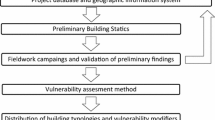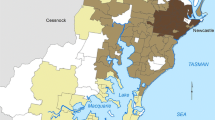Abstract
The concerted effort to collect earthquake damage data in Italy over the past 30 years has led to the development of an extensive database from which vulnerability predictions for the Italian building stock can be derived. A methodology to derive empirical vulnerability curves with the aforementioned data is presented herein and the resulting curves have been directly compared with mechanics-based vulnerability curves. However, it has been found that a valid comparison between the empirical and analytical vulnerability curves is not possible mainly due to a number of shortcomings in the database of surveyed buildings. A detailed discussion of the difficulties in deriving vulnerability curves from the current observed damage database is thus also presented.
Similar content being viewed by others
References
Borzi B, Pinho R, Crowley H (2008) Simplified pushover-based vulnerability analysis for large scale assessment of RC buildings. Eng Struct 30(3): 804–820
Borzi B, Crowley H, Pinho R (2008b) Simplified pushover-based earthquake loss assessment (SP-BELA) for masonry buildings. Int J Archit Herit (in press)
Braga F, Dolce M, Liberatore D (1982) A statistical study on damaged buildings and ensuing review of the MSK-76 scale. In: Proceedings of 7th European conference on earthquake engineering, Athens, September
Calvi GM, Pinho R, Magenes G, Bommer JJ, Restrepo-Veléz LF, Crowley H (2006) The development of seismic vulnerability assessment methodologies for variable geographical scales over the past 30 years. ISET J Earthq Technol 43(3):75–104; Paper No. 472
CEN—Comite Europeen de Normalisation (2003) Eurocode 8, design of structures for earthquake resistance – part 1: general rules, seismic actions and rules for buildings. Pr-EN 1998-1. Final Draft. December 2003
Crowley H, Pinho R, Bommer JJ (2004) A probabilistic displacement-based vulnerability assessment procedure for earthquake loss estimation. Bull Earthq Eng 2(2): 173–219 doi:10.1007/s10518-004-2290-8
Di Pasquale G, Orsini G, Romeo RW (2005) New developments in seismic risk assessment in Italy. Bull Earthq Eng 3(1): 101–128 doi:10.1007/s10518-005-0202-1
Dolce M, Masi A, Marino M, Vona M (2003) Earthquake damage scenarios of the building stock or Potenza (Southern Italy) including site effects. Bull Earthq Eng 1(1): 115–140 doi:10.1023/A:1024809511362
Dwairi HM, Kowalsky MJ, Nau JM (2007) Equivalent damping in support of direct displacement-based design. J Earthq Eng 11(4): 512–530
Faccioli E, Cauzzi C, Paolucci R, Vanini M, Villani M, Finazzi D (2007) Long period strong motion and its use as input to displacement based design. In: Proceedings of the 4th international conference on earthquake geotechnical engineering, Thessaloniki, Greece
Frassine L, Giovinazzi S (2004) Basi di dati a confronto nell’analisi di vulnerabilitàsismica dell’edilizia residenziale: un’applicazione per la città di Catania. In: Proceedings of the XI Congresso Nazionale “L’ingegneria Sismica in Italia”, Genova 25–29 January 2004 (in Italian)
Grünthal G (1998) “European macroseismic scale 1998,” Cahier du Centre Europeén de Géodynamique et de Séismologie, vol 15, Luxembourg
Gruppo di lavoro CPTI (2004). Catalogo Parametrico dei Terremoti Italiani, versione 2004 (CPTI04). INGV, Bologna
Iwan WD (2002) The use of equivalent linearization in performance based engineering. In: Proceedings of international conference on advanced and new challenges in earthquake engineering research, Harbin, China
Meroni F, Petrini V, Zonno G (2000) “Distribuzione nazionale della vulnerabilità” Chapter 6 of: Bernadini A (ed) La vulnerabilità degli edifici: valutazione a scala nazionale della vulnerabilità sismica degli edifici ordinari, CNR-Gruppo Nazionale per la Difesa dai Terremoti—Roma, 2000, 175 pp. + CD-ROM allegato (in Italian)
Orsini G (1999) A model for buildings’ vulnerability assessment using the parameterless scale of seismic intensity (PSI). Earthq Spectra 15(3): 463–483 doi:10.1193/1.1586053
Ordinanza del Presidente del Consiglio dei Ministri (OPCM) n, 3274 del 20 Marzo 2003 [2003] Primi elementi in materia di criteri generali per la classificazione sismica del territorio nazionale e di normative tecniche per le costruzioni in zona sismica. G.U. n. 72 del 8-5-2003. (in Italian)
Rossetto T, Elnashai A (2003) Derivation of vulnerability functions for European-type RC structures based on observational data. Eng Struct 25: 1241–1263 doi:10.1016/S0141-0296(03)00060-9
Rota M, Penna A, Strobbia C (2006) Typological fragility curves from Italian earthquake damage data. Proceedings 1st European conference on earthquake engineering and seismology, Geneva, paper no. 386
Sabetta F, Pugliese A (1987) Attenuation of peak horizontal acceleration and velocity from Italian strong-motion records. Bull Seismol Soc Am 77: 1491–1513
Sabetta F, Pugliese A (1996) Estimation of response spectra and simulation of nonstationary earthquake ground motions. Bull Seismol Soc Am 86(2): 337–352
Sabetta F, Goretti A, Lucantoni A (1998) Empirical fragility curves from damage surveys and estimated strong ground motion. In: Proceedings of 11th European conference on earthquake engineering, Paris
Scawthorn C, Iemura H, Yamada Y (1981) Seismic damage estimation for low- and mid-rise buildings in Japan. Earthq Eng Struct Dyn 9: 93–115 doi:10.1002/eqe.4290090202
Shinozuka M, Chang SE, Eguchi RT, Abrams DP, Hwang HHM, Rose A (1997) Advances in earthquake loss estimation and application to Memphis, Tennessee. Earthq Spectra 13(4): 739–758 doi:10.1193/1.1585978
Spence R, Coburn RW, Pomonis A (1992) Correlation of ground motion with building damage: the definition of a new damage-based seismic intensity scale. In: Proceedings of 10th World conference on earthquake engineering, Rotterdam
Whitman RV, Reed JW, Hong ST (1973) Earthquake damage probability matrices. In: Proceedings of the Fifth World conference on earthquake engineering
Zuccaro G (ed) (2004) Inventario e vulnerabilità del patrimonio edilizio residenziale del territorio nazionale, mappe di rischio e perdite socio – economiche. Available from URL: http://www.ingv.it/gndt/Att_scient/Prodotti_attesi_2004/Dolce_Zuccaro/Mappe/Start2.htm. (in Italian)
Author information
Authors and Affiliations
Corresponding author
Rights and permissions
About this article
Cite this article
Colombi, M., Borzi, B., Crowley, H. et al. Deriving vulnerability curves using Italian earthquake damage data. Bull Earthquake Eng 6, 485–504 (2008). https://doi.org/10.1007/s10518-008-9073-6
Received:
Accepted:
Published:
Issue Date:
DOI: https://doi.org/10.1007/s10518-008-9073-6




